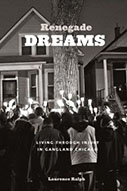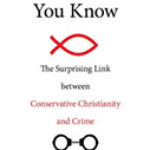Renegade Dreams: Living through Injury in Gangland Chicago

Author: Laurence Ralph
Publisher: Chicago, IL: University of Chicago Press, 2014. 256p.
Reviewer: Tim Delaney | May 2015
Renegade Dreams is an ethnographic-style study of Eastwood, a Chicago gang-infested community, and is written by Laurence Ralph, an assistant professor in the Departments of Anthropology and African American Studies at Harvard University. Ralph lived in this West Side Chicago neighborhood from 2007 through 2010. He interviewed “gangbangers,” church leaders, drug addicts, AIDS patients, gun shot victims and members of the community who are often caught in the cross-fire of gun violence. He prides himself in his ability to listen to the people’s hopes and dreams and how they imagine alternative futures for themselves.
Ralph details how it was often tough for him to do ethnographic research because when he wrote up his notes and showed them to the subjects he interviewed, he had to find the balance between his desire to, essentially, keep the book real, while also trying to appease some who took exception to his literal interpretation of conversations to which he had listened. For example, Ralph discusses how he had recorded members of a political action group called the Neighborhood Coalition. As he listened to one woman, Mrs. Pearl, at the meeting, Ralph reports it sounded like she said, "Tiko can help us wit passing out dem flyers. He’s always at our meetings, tryna figure out what he can do." When he showed Mrs. Pearl the transcript of the conversation, she wanted him to clean it up so that she would not sound so ignorant. She wanted "wit" changed to "with," "dem" to "them," and "tryna" to "trying to." While she admitted to Ralph that she actually sounded (on the recording) like what he had written, she chided the author and said, "You’re supposed to be educated boy." Ralph writes, she "even shook her head" [at him]. As a gang researcher myself, I can relate to the author’s concerns about finding the balance between trying to "keep it real" while appeasing others; such is the life of a gang researcher who interviews gang members and related or involved others.
Adding to his concern for presenting a fair representation of actual dialogues between himself and those he interviewed, the author discusses a controversial subject—"talking in the vernacular." Ralph indicates that regardless of race, the people he interviewed all "spoke in what linguists refer to as African American Vernacular English (AAVE) as opposed to Standard American English (SAE)" (p. xviii). Ralph reasons that keeping the "richness" of AAVE adds to the authenticity of his book; however, some folks, such as Mrs. Pearl, preferred her voice to be standardized. Thus, like so many others before him who have conducted ethnographic research, Ralph admits that at times certain quotes attributed to one person may have actually come from another and that he created composites of people’s responses to form fictional characters; he did the same with some of the organizations. For example, the author informs us that the Eastwood Community Church is actually a composite of more than one church on the West Side of Chicago and that "Pastor Tim" is a composite of more than one pastor.
Disappointingly, Ralph also decided not to specifically reference any of Chicago’s notorious street gangs, any of the infamous neighborhoods, or to include any photos of the neighborhood (e.g., buildings with graffiti or actual gang members). Still, his decision not to name specific gangs and gang members is common with this type of book. Felix Padilla, for example, did the same thing in his The Gang as an American Enterprise (1993) when he interviewed Chicago gangs, their family members, and members of the community more than two decades ago. Padilla used the fictitious named "The Diamonds," but he gave readers enough hints (e.g., their nation affiliation) to figure out who they really were. As Ralph does in Renegade Dreams, Padilla also described the future dreams and aspirations of the gang members and their hopes for a life outside of the gang.
Laurence Ralph uses the name "Divine Knights" to identify the primary Eastwood street gang. The Divine Knights are a part of the "Family Alliance." [Note: In Chicago, it is typical for most gangs to have an alliance with either the People or Folks Nation. Each of these nations is identified by a variety of markers such as wearing specific colors and the implementation of a number of specific symbols when they mark territory (e.g., through the use of graffiti).] Ralph describes a number of specific gang identifiers used by the Divine Knights: the cane, top hat, dice and playboy bunny rabbit. All of these symbols are commonly used by the Vice Lords of the People Nation. That does not mean, however, that the "Divine Knights" are Vice Lords, as Ralph may have purposively used rival gang symbols so as to keep the anonymity of the Divine Kings. Nonetheless, symbolism is very important in the gang world. The author describes the importance of the cane as it comes from the Divine Knights handbook: "The cane represents strength. Symbolically, the strength the cane represents comes from our elders, who use it for physical support…The cane also represents the need for all Knights to support one another in these trying times. This symbol means: ‘I’m Conscious’" (p.26).
The Renegade Dreams book title takes on special meaning to Ralph. He explains that "Renegade Dreams" refers to "an inspiration in an experience of injury that reimagines the possibilities within injury." In other words, even in despair, people have hopes and dreams for a future that is an alternative to what might seem inevitable, given the life circumstances of the people with whom he has interacted. Dreams come in a variety of forms and take on special meaning for African Americans. For one, dreams are linked to social activism. Second, among the most popular expressions used by Martin Luther King Jr., was "I have a dream." Third, Ralph describes how Barack Obama wrote a memoir of his father titled "Dreams of My Father," written just prior to when he launched his political career. This all serves to encourage people to dream and to try to reach their dreams. Still, as optimistic as the author appears to want to be, he admits that the odds are against the folks of Eastwood. Ralph summarizes his ideas on the people of Eastwood pursuing their dreams as follows: "…despite the statistical odds against their dreams coming to fruition in such a context, I foreground the resilience it takes for black Chicagoans to keep dreaming anyway" (p. xx).
The dreams of most residents of Eastwood are not grandiose. They dream of things that most people already have, and take-for-granted, including a safe passage to school for kids, since in Eastwood, some students have to walk through rival gang neighborhoods and face violence on a daily basis. They dream about having a stable job, since more than half of the community members of Eastwood are unemployed. And, they dream about and pray for livable housing. But too many of these dreams are not realized in Eastwood. Too many children are gunned down on the streets on their way to school; adults look for employment that does not exist; and, gentrification programs threaten to take the homes of hundreds of Eastwood residents.
The author goes into great detail about the local politics of Eastwood, especially with regard to the various nonprofit organizations—there are nearly 180 of them—and the local churches—there are 187, on record. He details the relationship between the organizations and churches and the greater community, and the influx of outside developers who want to destroy old and dirty buildings in favor of new housing developments. He describes a woman, Tamara Anderson, a clever local resident who wants to build a museum in Eastwood. In a pragmatic effort to keep the peace of, and the gain the support of, the Divine Knights, Anderson would include a display in her museum that would essentially pay homage to the Divine Knights. The Knights, as we learn, were once a politically active street gang that had worked with Rev. Martin Luther King, Jr. in the 1960s. In fact, King lived with his family near the Eastwood area in the 1960s.
Most people are aware of the fact that gang violence exists in many cities and suburbs across the United States. And they understand that in larger cities, like Chicago, murder is a common outcome of gang violence. Ralph makes a point of highlighting gang violence that leads to injury. He describes how many people in Eastwood are in wheelchairs, and it’s because of gang involvement. Ralph describes the case of Justin, a gang member who was shot and lost the ability to use his legs, leaving him wheelchair-bound. Justin was lucky to live, and he claims to have found religion and wants to repent. When he was in his hospital bed after being shot, Justin told the gang leader Kemo not to seek revenge in his name. Justin told the author that he wanted to become a political activist and try to help steer youth away from gangs. Ralph provides a rather compelling description of Justin’s life-altering moments in Renegade Dreams. Justin has reached the point where he is on stage telling students about what can happen if you join a gang. Many of the kids are not paying much attention — they’ve heard anti-gang speakers before — but as Justin continued with his story, he had everyone’s undivided attention.
Renegade Dreams is a worthy addition to the large body of ethnographic literature on gangs, but unfortunately, it offers little specifically new knowledge about those street gangs.
Tim Delaney is a Professor and Department Chair of Sociology at the State University of New York at Oswego.


